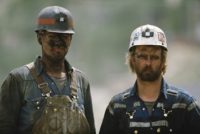Safety is a process, and as such, needs to be managed. This section offers resources to create a viable safety program, sell it to senior management, train supervisors and employees in using it, and then track and report your progress. Look also for ways to advance your own skills in these areas, both for your current job, and those that follow.
In Friday’s Federal Register, OSHA published three Susan Harwood Training Grant funding opportunity announcements for Targeted Topic Training Grants, Training and Educational Materials Development Grants, and Capacity Building Grants. The grants are meant to support worker health and safety training.
Struck-by object is one of OSHA’s Construction Focus Four topics (along with falls, electrocution, and caught-in-between), collectively the four hazards that year-to-year result in more than half the fatalities in the construction industry.
It’s one of the most instantly recognizable hazards when you step onto many worksites—noise. A lot of us tend to think, well, just use some PPE, and that’s that. However, there’s much more to a hearing conservation program than meets the eye, or, shall we say, meets the ear. What are some of the things […]
OSHA’s recent proposal to add a permanent requirement that employers ensure the competency of crane operators through evaluation is intended to correct a prior requirement—which is not yet in effect—that certification alone of crane operators is sufficient to demonstrate operator competency. Compliance with the certification-only standard, which was issued in 2010, is currently required by […]
Remarkably, coal workers’ pneumoconiosis (CWP), better known as black lung disease, afflicting coal miners in Appalachia appears to be on the rise, reports the National Institute for Occupational Safety and Health (NIOSH).
OSHA reports that Recommended Practices for Safety and Health Programs is one of its most popular guidance publications. The agency originally published this document in 1988 and issued the first update in October 2016. In that revision, OSHA stated that much had changed over the preceding 28 years in the nature of work, conditions in […]
OSHA’s proposed amendments to its Cranes and Derricks in Construction: Operator Qualification standard (May 21, 2018, Federal Register (FR)) contains what some employers seem to be interpreting as two contradictory positions. The proposal adds a requirement that employers must conduct evaluations to ensure that the equipment operator possesses “the skills, knowledge, and judgment necessary to […]
After years of sputtering progress, the Department of Homeland Security’s (DHS) Chemical Facility Anti-Terrorism Standards (CFATS) program is beginning to resemble a well-run, if not yet mature, government-industry undertaking.
Our experts at Safety.BLR.com were recently asked, “What industries does OSHA consider as Special Industries?” Here is what they had to say.
From an employee’s acceptance of a job through the prehire process and into day 1 at the organization, your company’s onboarding practices set the tone for the success—or failure—to come. Is your onboarding program boosting your safety culture, or is it hindering it? Read on for some safety culture onboarding best practices in a Q&A […]










